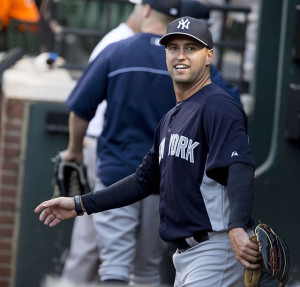Known more in the minds of many Yankees fans more as the guy who took Phil Hughes’s spot in the rotation in September 2013 and proceeded to give up 9 runs in 3.1 innings against the Red Sox, David Huff came back to the Yankees this past June after being cast off from the eventual world champion Giants with, carrying a 6.30 ERA to the Bronx. All Huff did was go on the best run of his career, pitching to the tune of a 1.30 ERA in a solid 39 innings of work. Let’s take a look at how the man with a career 5.02 ERA turned around his season with the Yankees this year.
Huff, who is 30, has been around since 2009, when he debuted as a starter for the Indians. He was mediocre as a primary starter from 2009-2012, going 18-26 with a 5.30 ERA, a 1.62 K/BB ratio, and an ugly 10.9 H/9. The Indians transitioned him to the bullpen in 2013 before giving up on him after 5 earned runs in three innings. The Yankees picked the lefty up off the scrap heap and he actually pitched pretty well. If you ignore his start filling in for a Phil Hughes that was as painful to watch last year as he was record-breaking this year, Huff logged a 2.59 ERA in 9 relief appearances and one spot start. However, the Yankees didn’t bring him back, as the Giants purchased him in January.
Upon his return to New York, however, Huff wouldn’t let the Yankees forget about him. Beyond his stellar ERA, Huff lowered his H/9, HR/9, and increased his strikeout rate. How did this happen? A look at the pitch data from BrooksBaseball.com provides the answers: Huff’s repertoire. Huff added a sinker, relied more heavily on his cutter, and limited the use of his changeup. Let’s look at each of these pitches.
BrooksBaseball doesn’t have any data for Huff’s sinker before coming to the Yankees. It’s just not there. It was in the 11-day gap between his last appearance for the Giants and first for the Yankees that Huff added the pitch to his arsenal, and he saw immediate results. He threw the pitch 5% of the time, and it produced 6.25 ground balls for every 10 of them that were put in play. Huff’s sinker closely resembled his fastball in velocity, which likely made it difficult for batters to recognize.
Huff’s cutter came to be a weapon as well. He threw it about 20% of the time in his three months as a Giant, and that was a significant increase from 2009-2013, in which he only threw it under 3%. However, after returning to New York, Huff chucked the pitch at a clip of 36%. Huff used the pitched as a weapon whenever he was ahead in the count, and it produced 4.85 ground balls per 10 balls in play. It was also good for a swinging strike or a foul ball 70% of the time an opposing batter put a swing on it.
Huff also ditched the changeup for the most part. It hasn’t been very successful for him throughout his career, as batters have hit .298 against it with an ISO of .205. The changeup also produced the highest ratio of home runs per balls hit in the air for any of Huff’s pitches. The changeup looked even worse especially while Huff was in San Francisco, as hitters absolutely pummeled the pitch even more than they had before. None of that changed when he came to the Yankees—except for the fact that the frequency at which he threw the pitch decreased from 19% over his career to 8% once he joined the Yankees.
Huff’s improved average fastball velocity also contributes to his improved showing in 2014, as it was bumped up by nearly an entire mile per hour after switching coasts. Pitches like the cutter and sinker will be crucial going forward, especially for a ground ball pitcher like Huff who doesn’t have dominant stuff. That makes three relative scrap heap finds for the 2014 Yankees moundsmen, as Huff joins Brandon McCarthy and Rich Hill as guys who logged strong innings for the team beginning midway through the season. It’s hard to say whether it was the change of scenery, the presence of Larry Rothschild, or the mystique of the pinstripes that helped these three men improve so much, but the differences between their pre-Bombers and Bombers selves are apparent when looking at their pitch repertoires.
Huff is an undervalued bullpen arm. For a team that needs as much pitching as it can get with numerous injuries to the starting rotation and the possible departure of closer David Robertson, it might not be a bad idea to bring the inexpensive lefty back on a one-year deal.




